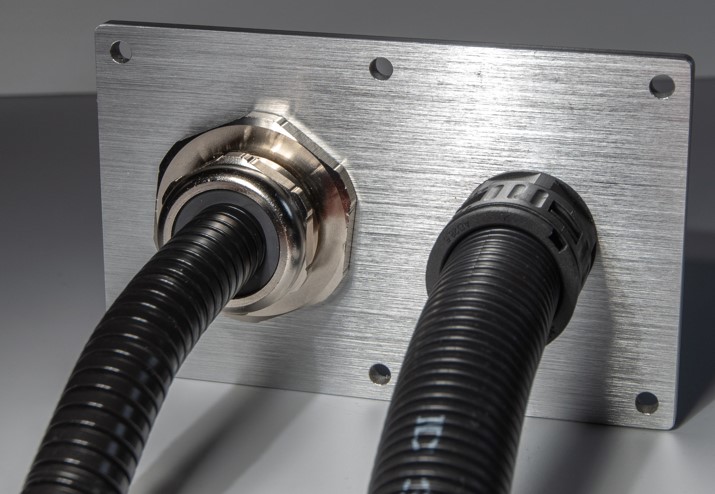Pflitsch blueglobe TRI with T80s insert - effective EMC shielding and fire protection

Electromagnetic interference produced by on-board electrical installations in vehicles and ubiquitous electronic devices can lead to permanent damage and malfunction of some applications. Solution designers are therefore looking for components that will ensure an appropriate level of safety by withstanding high current in shielded cables. In the group of cable glands, the top solution is blueglobe TRI with a patented shielding spring. Equipping it with an insert made of thermoplastic elastomer allowed the manufacturer, Pflitsch, to create a product perfectly suited to demanding application areas. The stuffing box meets the highest standards in the protection of railway applications, reaching the HL3 level for the EN 45545-2 standard and E30 for the EN 45545-3 standard.
The blueglobe TRI cable gland made of nickel-plated brass uses two unique solutions from Pflitsch, creating a versatile component intended for demanding applications.
The first is a patented insert with a spherical structure made of thermoplastic elastomer (T80s). It guarantees:
- large clamping range (54 – 5 mm),
- exceptional tightness at the level of IP68 and IP69,
- impressive strain relief on a large surface, protecting the cable from damage
- wide operating temperature range ranging from -40°C to +130°C, which allows the gland to be used in all standard applications in the railway industry.
In extreme conditions, the optional silicone insert (S55) will work well, resistant to frequent temperature fluctuations ranging from -55 to +180°C, weather conditions, operating fluids and lubricants.
The unique effect of the globe insert, which protects the cable against tearing and common damage, e.g. the corkscrew, can be seen well on the following video:
The second mentioned solution is a shielding spring (EMC) with a patented triangular shape. Its greatest advantages include:
- 360° shielding,
- guarantee of low impedance on a large surface,
- possibility of transferring high currents from shielded cables,
- high attenuation of electromagnetic interference in the range of up to 1 GHz,
- maintaining high efficiency even in the upper frequency range,
- sure, strong contact of the cable shield with the cable gland body even under the influence of vibrations.
For particularly demanding solutions, Pflitsch has prepared a blueglobe TRI gland with an optional, non-magnetic spring made of CuSn6 (tin bronze), which further improves noise suppression and conduction of strong currents.
The small number of individual gland parts and the lack of complicated clamping that would require the use of special tools make blueglobe TRI extremely easy to install and does not cause problems in the subsequent operation and maintenance of the devices.
The blueglobe TRI gland can be used in applications that require effective and long-lasting shielding of electromagnetic interference. One such area in rail vehicles is converters. In addition, the cable gland is perfect for applications that require:
- a component that creates an efficient protective barrier between the device and the surroundings, minimizing the risk of fire and limiting the spread of fire and the emission of harmful smoke and gases;
- resistance to:
- strong vibrations,
- frequent temperature fluctuations,
- UV radiation and dynamically changing weather conditions,
- water and dust ingress;
- protection against contact corrosion at the cable entry.

The fire protection properties of the blueglobe series glands are presented on Monlower movie:
It is also worth mentioning that at the beginning of 2023, blueglobe TRI was the first cable gland on the market to pass the category 8.2 test conducted by the Society for High Frequency Measurement Technology GHMT. The task was to check whether the use of a cable gland could degrade the high data transmission rates in Ethernet cables up to 40 Gb/s. The test showed that the use of the gland meets the IEC 61156-9 standard in the transmission frequency range from 1 GHz to 2 GHz.

